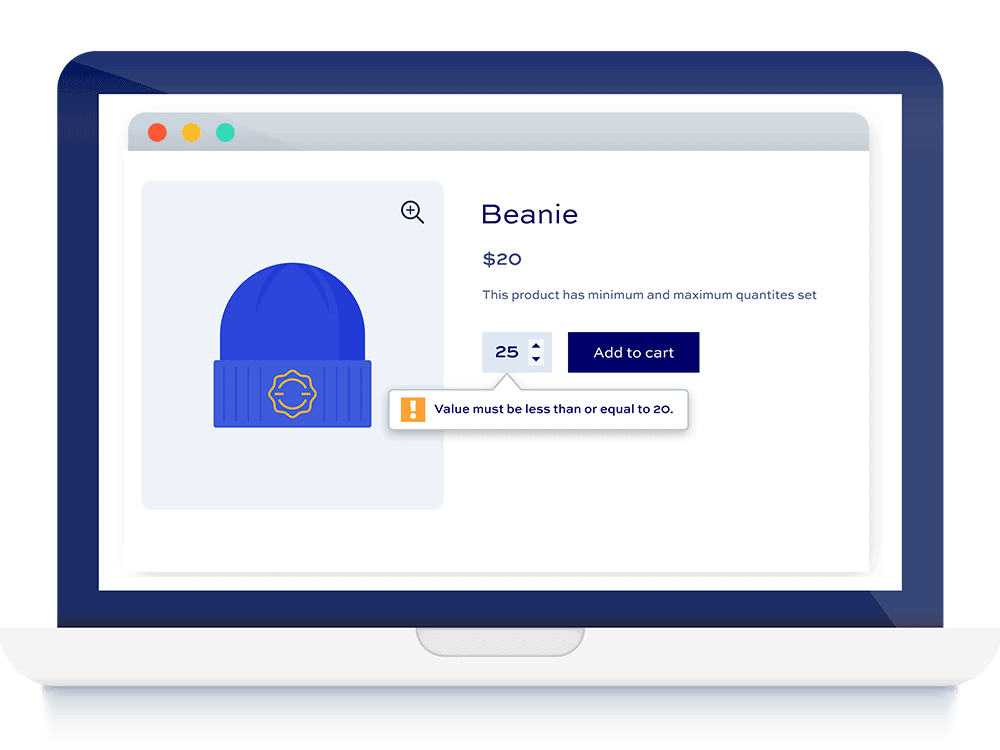How to Create Quantity Increments in WooCommerce: A Guide

While the default settings in WooCommerce are designed to accommodate a wide range of retail scenarios, they might not perfectly align with the diverse needs of every business. One common challenge faced by store owners is the default quantity increment of 1, which might not suit all types of products or customer preferences.
Consider the scenario of wholesalers, trade-only shops, and businesses dealing in bulk quantities. For these enterprises, selling in larger increments or quantities is not just a convenience but often a necessity. Imagine a wholesale distributor attempting to sell individual items rather than in bulk – it not only disrupts the ordering process but also undermines the efficiency that such businesses thrive upon.
This is where the concept of quantity increments comes into play. The ability to allow customers to order in predefined quantities that align with the nature of the products being sold is a pivotal aspect of a streamlined purchasing process. Such increments not only enhance the customer experience but also contribute to transparent communication, mitigating the chances of misunderstandings and costly errors.
In this comprehensive guide, we delve into the intricacies of setting up quantity increments in WooCommerce. From the technical aspects of configuring your store to facilitate smooth order quantities to the art of communicating these increments effectively to customers, we’ve got you covered. We’ll explore the pitfalls of overlooking this crucial feature and showcase how getting it right can lead to a seamless shopping experience and bolstered customer satisfaction.
Let’s dive in and unlock the power of precise ordering experiences with WooCommerce!
Understanding the importance of quantity increments in WooCommerce
Quantity increments refer to predefined steps by which the quantity of a product can be adjusted when placing an order. Rather than allowing customers to order any arbitrary quantity, quantity increments impose a structured approach, enabling customers to select quantities that align with specific values or packages. Here’s why adding quantity increment rules in your shop page can enable you to optimize the user experience, manage orders, and potentially increase sales:
- Efficient wholesale and bulk transactions: For businesses dealing with wholesale or bulk orders, quantity increments establish a logical and cost-effective ordering process. By setting predefined quantities, you streamline the transactional flow and ensure that the cost of shipping aligns with the quantities ordered.
- Use Case: Imagine you run a wholesale office supply store catering to businesses that regularly order in bulk. One of your popular products is printer paper, usually ordered in packs of 50 reams. By setting up quantity increments with a step of 50, customers can easily order in multiples of 50 reams.
- Precise inventory management: Quantity increments play a pivotal role in efficient inventory management. They allow you to move stock more strategically by encouraging customers to order in specific quantities. This helps prevent overstocking and ensures that your inventory remains in line with actual demand.
- Use Case: Let’s say you manage an electronics store selling laptop batteries. These batteries are commonly sold in packs of 5 to cater to laptop repair businesses. By implementing quantity increments with a step of 5, you encourage customers to order in these sets.
- Rapid clearing of products: When it comes to clearing out products, quantity increments become a valuable tool. By setting up minimum order quantities, you motivate customers to purchase larger quantities, facilitating the clearing of old or slow-moving inventory.
- Use Case: Consider a fashion retailer with a surplus of last season’s apparel. To swiftly clear out these products, you set a minimum order quantity increment of 10 for clearance items. By doing so, you motivate customers to purchase larger quantities, making the remaining inventory move faster. This approach allows you to free up space for new arrivals and prevent stale inventory from occupying valuable shelf space.
- Viable minimum quantity rules: Setting minimum quantity rules through increments ensures that your sales remain economically viable, especially for low-value items. Customers are prompted to meet these minimum thresholds, optimizing shipping costs and preventing inefficient small orders.
- Use Case: In the realm of cosmetics, selling individual makeup samples might not be cost-effective due to shipping expenses. By implementing a minimum quantity rule, such as a step of 5, you encourage customers to order a minimum of 5 samples in a single purchase.
How do you increase product quantity in WooCommerce
While WooCommerce by default doesn’t come with the option to set custom quantity increments, it’s very possible to add this functionality to your store. Developers can dive into the site’s functions.php file within the child theme to add the functionality, but for non-developers and most WooCommerce store owners, using plugins is the better option.
Plugins offer a secure and user-friendly solution, sparing shop owners the complexities of coding. Once you’ve selected and installed the suitable WooCommerce plugin, adjusting quantity increments becomes straightforward, ensuring seamless website functionality.
How to evaluate which quality increment plugin is right for you?
When it comes to optimizing your WooCommerce store for quantity increments, the right plugin can make all the difference. As you embark on this journey, it’s crucial to keep an eye out for key features that empower you to fine-tune your store’s ordering experience. Here are the fundamental aspects to consider when evaluating a quantity increments plugin:
- Global and individual customization: A robust plugin should provide the flexibility to configure quantity increments both globally and on an individual basis. This means you can define standard increment rules for your entire store, while also having the ability to fine-tune quantities for specific products.
- Tailored quantity options: Look for a plugin that grants you control over incremental steps for items sold either individually or in bulk. This level of customization ensures that each product can adhere to its unique ordering requirements.
- Text and messaging: An exceptional WooCommerce plugin goes beyond functionality and allows you to add descriptive text to replace numerical quantities, as well as error labels to highlight quantity rules. This enhances clarity for your customers and can serve as a strategic tool to encourage larger orders.
- Dropdown quantity selection: The ability to employ a dropdown list for your quantity field offers users a rapid and intuitive way to select from available increment options. This ensures that customers quickly comprehend the quantities they can order, leading to a smoother purchasing process.
How WooCommerce Minimum Maximum Quantity and Order can help you set and manage quantity rules
The WooCommerce Minimum Maximum Quantity and Order plugin offers an all-in-one solution for creating quantity increments on your WooCommerce site.
WooCommerce Minimum Maximum Quantity and Order
Maximise your store’s revenue by setting rules on quantity and values
The intuitive plugin is designed to help shopkeepers increase revenue and make the most out of their online stores by setting rules on quantities and values. This way, store owners can remove the limitations of default WooCommerce and prevent extra costs associated with order returns.
The WooCommerce Minimum Maximum Quantity and Order plugin’s quantity increments functionality is very useful for most types of online stores. Using the plugin’s advanced quantity features, store owners can set custom quantity increments for individual products or for all products on their online store. This allows you to set increments as well as custom step values that don’t follow specific increment rules such as “pack of 3, pack of 5, pack of 10”.
The plugin is highly flexible to suit different use cases making it functional for any kind of WooCommerce store. For example, if you run a wholesale shop and only want to move large quantities of a product, you can sell products in large increments like boxes of 50 units, and use custom quantity step increments to reflect this.
Similarly, if you’re an artist that sells prints to both individual customers and art shops, custom step increments let you offer different batch amounts as well as single prints for the different types of customers on your online store.
More features your shop may use
Other than quantity increments, the WooCommerce Minimum Maximum Quantity and Order plugin offers a wide array of quantity features that make it easier to sell and manage products with custom quantities.
For starters, you can set the default quantity for any product. This is a great way to offer clear communication to your shoppers when they want to purchase products with quantity rules. The plugin also lets you set order minimums and maximums based on the cart total or the number of products purchased. As a result, it encourages customers to spend more and helps your business generate more revenue.
WooCommerce Minimum Maximum Quantity and Order lets you apply changes to your shop’s products globally or individually as well as setting quantity rules based on user role.
Step-by-step: Customizing quantity increments with WooCommerce Minimum Maximum Quantity and Order
In this tutorial, we’ll explain how you can get started customizing the quantity increments for your online store’s products using the WooCommerce Minimum Maximum Quantity and Order plugin.
Step #1: Install and activate the plugin
Get the WooCommerce Minimum Maximum Quantity and Order plugin and install it on your WooCommerce site. To do this, navigate to Plugins → Add New from the WordPress admin panel and upload the.ZIP file to your site before clicking on the Install Now button.
Once the plugin is installed, make sure to click on the Activate this plugin link to continue. Now, navigate to WooCommerce → Settings → Min Max, and then click on the Licence link from the top. Paste the license key given to you at the time of purchase in the text field.
Click on the Activate License button to continue.
Step #2: Set rules for each product
Now that the WooCommerce Minimum Maximum Quantity and Order plugin is installed and activated on your site, we can start setting up quantity increment rules for your WooCommerce products. To get started, navigate to WooCommerce → Min Max Rules and click on the Add New button.
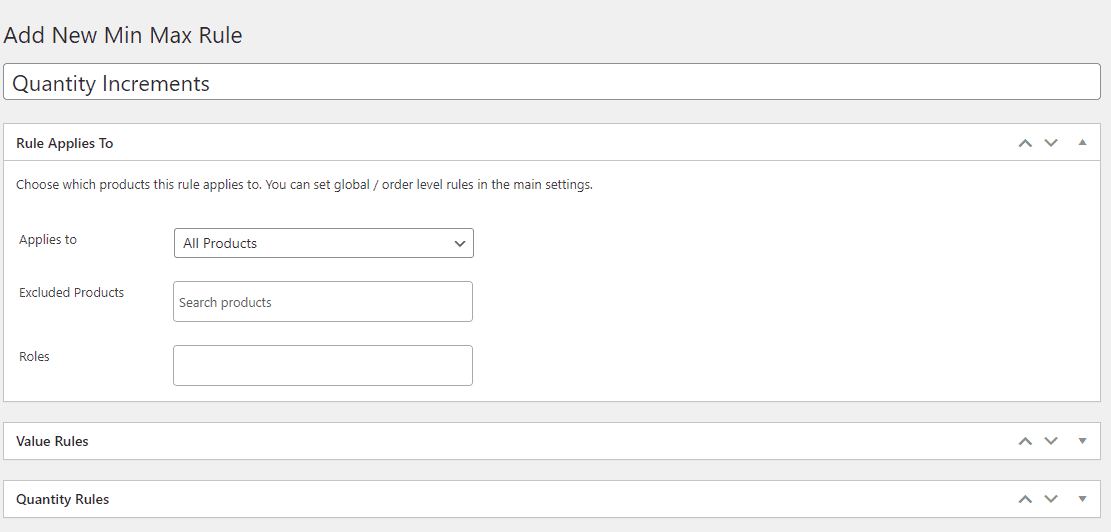
After giving your quantity rule a new title, specify the products you want to showcase custom quantity increments for using the Applies to the dropdown menu. For example, if you want to set up the quantity increments for apparel products only, you can select the Specific Categories option and then select the correct product category.
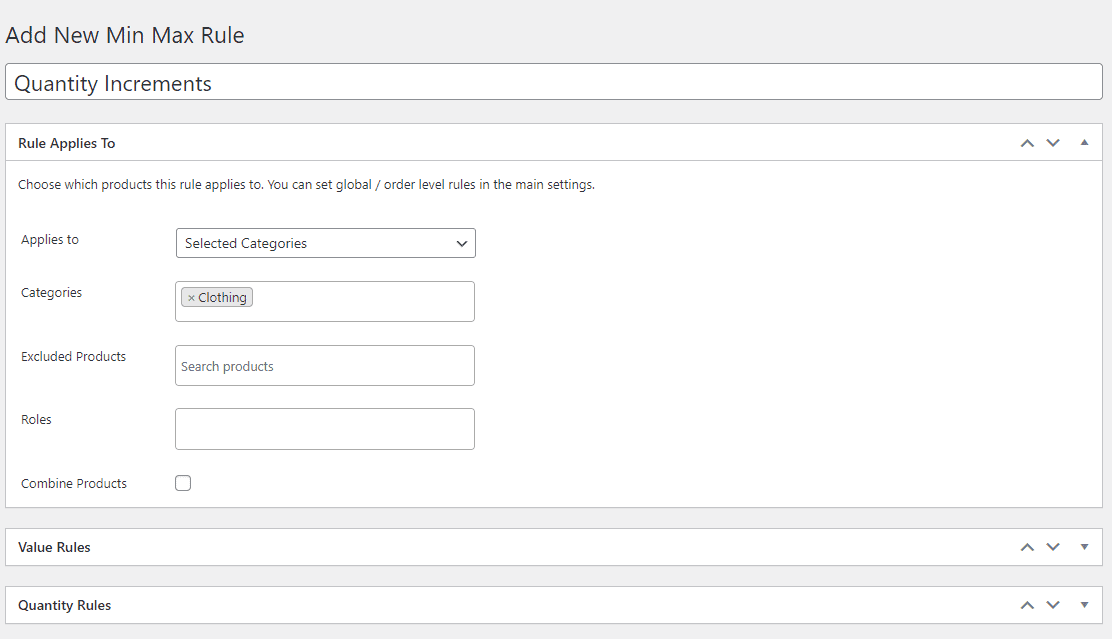
Similarly, you can also specify individual products from your entire shop’s catalog or display quantity increments on your online store globally. Specify the quantity increment value you want to set for your selected products using the Quantity Increment text field under the Quality Rules dropdown menu.
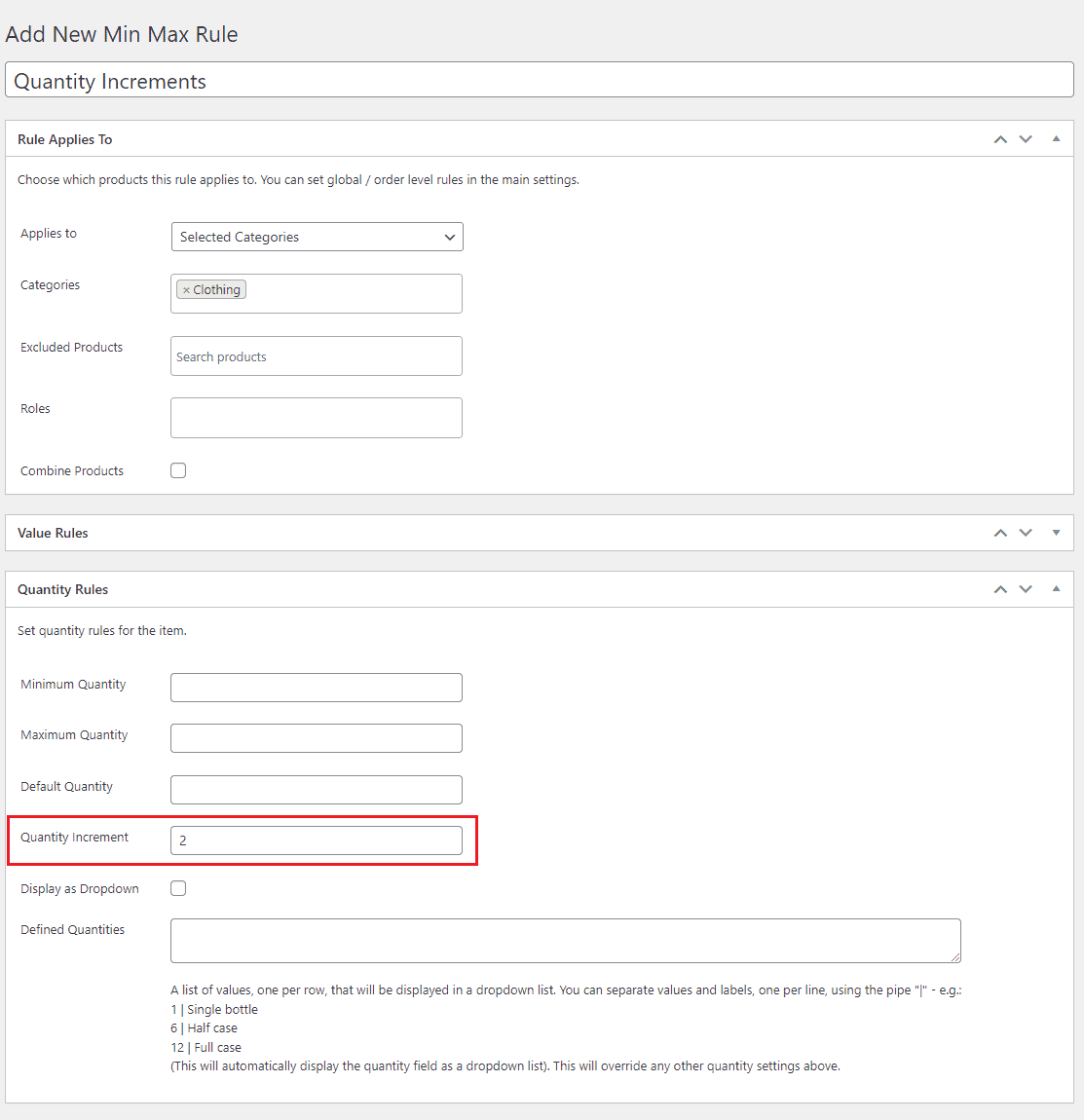
Once you’re ready, click on the Publish button to continue.
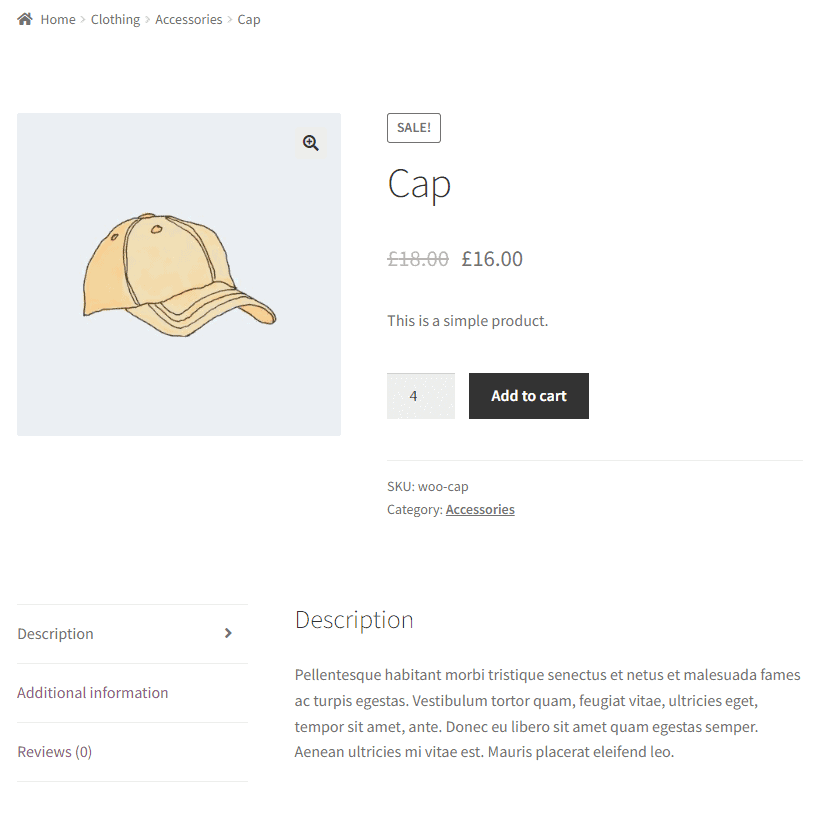
Shoppers on the front-end will only be able to increase the quantity of the specified products in custom quantity increments. This is useful for trade-only shops or wholesalers that want to sell products in multiples or in larger quantities.
Step #3: Customize the quantity field
The WooCommerce Minimum Maximum Quantity and Order plugin also lets you customize the quantity input field in a number of ways other than creating custom quantity increments.
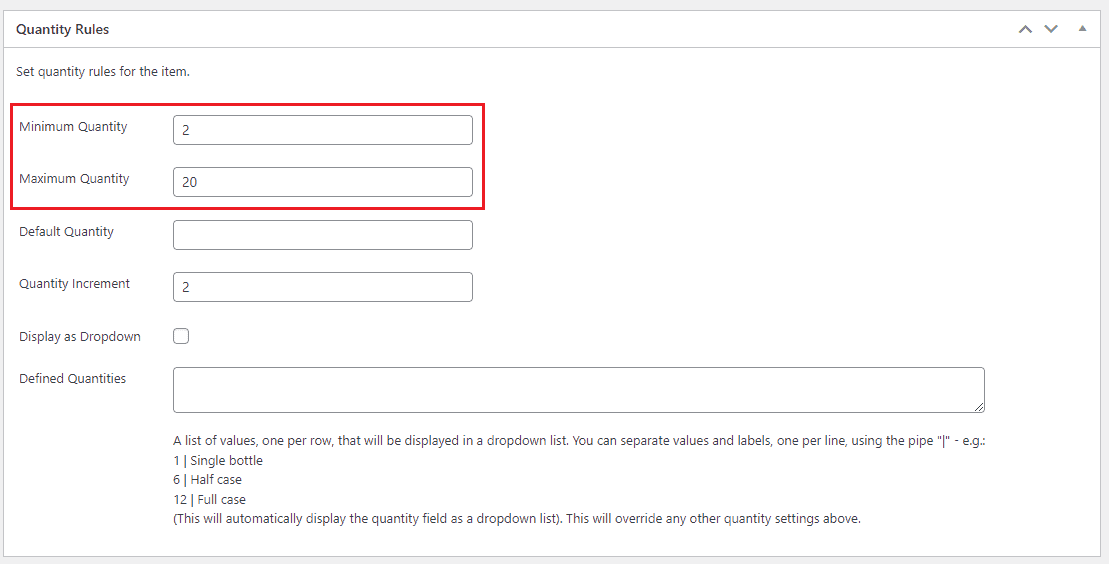
For starters, you can set minimum and maximum quantities for your products so customers don’t end up ordering too little or too much from your online store. For example, store owners can set minimum order quantities for products that aren’t profitable for selling in lower quantities. Similarly, wholesale stores can set maximum quantity limits on products on sale so multiple customers get a chance to purchase the products before stock runs out.
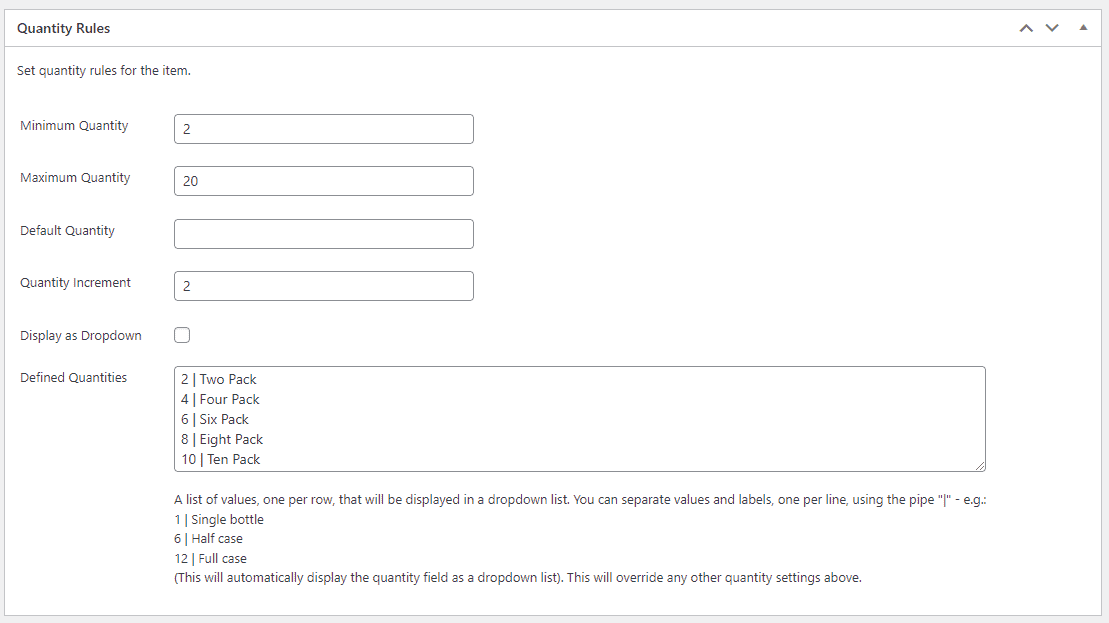
You can also add custom quantity selectors for your WooCommerce products using the Defined Quantities field. For this, you need to specify the quantity value and quantity label using the “|” symbol and add as many quantity selectors to your products as you’d like.
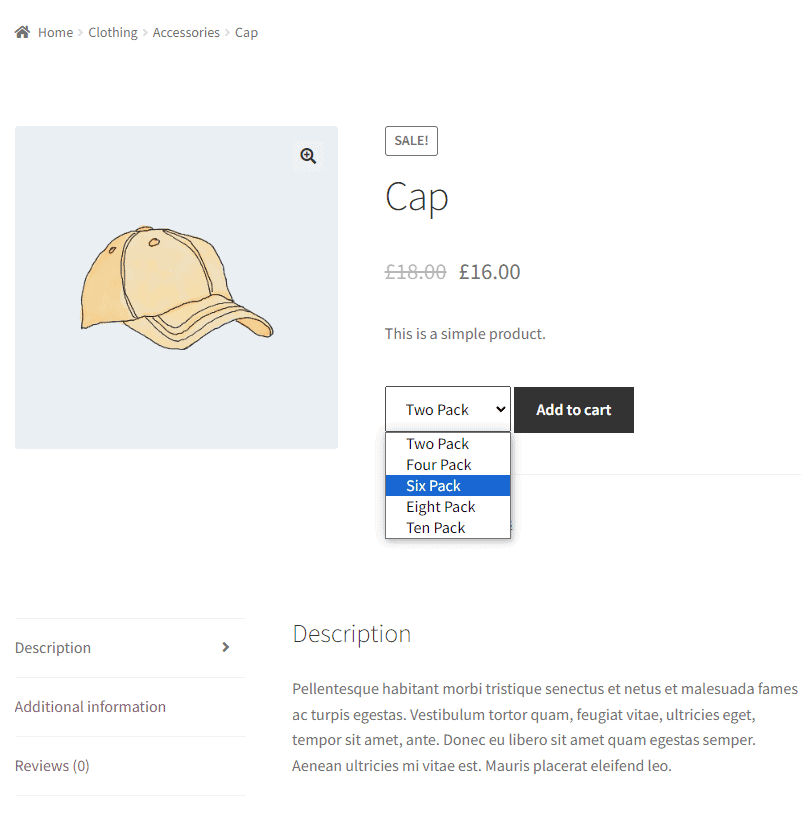
This is useful for selling products on your online store that come pre-packaged in custom quantities and makes it easier for shoppers to better understand the quantity rules on your WooCommerce site.
Testing and best practices to optimize quantity increments in your WooCommerce store
Setting up quantity increments in your WooCommerce store isn’t just about enhancing the ordering process—it’s also a valuable avenue for collecting insightful data about your sales strategy. To ensure you’re harnessing this feature to its fullest potential, it’s essential to follow testing and optimization best practices. Here’s how to effectively measure and refine your quantity increment strategies:
- Utilize quantitative insights: The implementation of quantity increments provides a unique vantage point into customer purchasing behavior. Pay attention to trends and patterns that emerge as you introduce or modify increments. Are customers responding positively? Are there certain products or categories where these increments have a more pronounced impact.
- Continuous monitoring: To gauge the effectiveness of your modifications, compare sales rates before and after implementing new quantity increments. A decline in sales could indicate a misalignment with customer preferences or confusion in the ordering process. Conversely, an increase signifies that your approach is resonating with your audience.
- Identify patterns: As you periodically check the impact of your quantity increment changes, look for recurring patterns. Consider checking on a weekly or monthly basis to capture both short-term and longer-term trends. These patterns can provide invaluable insights into customer behavior and the success of your optimization efforts.
- Iterate and refine: The beauty of data-driven optimization lies in its iterative nature. Use the information you gather to refine your quantity increment strategies. If certain increments aren’t yielding the expected results, consider tweaking them or trying different approaches. The ability to adapt and fine-tune is key to maximizing the benefits of this feature.
Use quantity increments to take your WooCommerce shop to the next level
In this article, we’ve looked at the benefits of customizing quantity increments in your WooCommerce store, which is especially important for bulk wholesalers but can be equally important in a range of other use cases. Setting custom quantity increments makes the ordering process more efficient and allows you to manage your inventory better while selling in higher volumes.
It’s important to choose an intuitive plugin like WooCommerce Minimum Maximum Quantity and Order that offers seamless compatibility with your existing website and plugins and comes pre-built with advanced quantity features. For these reasons, the WooCommerce Minimum Maximum Quantity and Order plugin is the ideal solution for WooCommerce store owners looking to improve their store’s functionality and user experience with quantity increments.
WooCommerce Minimum Maximum Quantity and Order
Maximise your store’s revenue by setting rules on quantity and values
Ready to start creating quantity increments in WooCommerce? Get WooCommerce Minimum Maximum Quantity and Order today!
